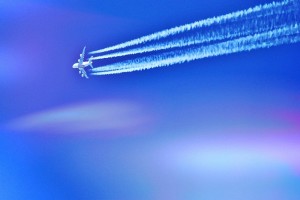
Washington D.C.: Aircraft engines emit a variety of combustion products including 3.16 kg of carbon dioxide (CO2) and about 1.23 kg of water vapour (H2O) for every kg of fuel burned. At the cold temperatures that are typical of cruise altitudes, the H2O rapidly condenses onto co-emitted soot particles and pre-existing atmospheric particles. The small water droplets continue to grow in size as the engine exhaust plume cools until they eventually freeze, forming a visible line-shaped condensation trail, or contrail, that consists of several hundred ice crystals per cubic centimetre of air.
Ice crystal contrail formations can linger in the upper atmosphere for hours and affect the way Earth is heated and cooled. They produce localized increases in temperature – which over time impacts climate change.
“We know that contrail formation from jet exhaust has a larger, more immediate impact on climate than carbon dioxide emissions,” said Richard Moore, a NASA scientist at Langley Research Center in Virginia.
A new research now shows that cleaner-burning jet fuels made from sustainable sources can produce 50%-70% fewer ice crystal contrails at cruising altitude, reducing aviation’s impact on the environment, according to research conducted by NASA and the German Aerospace Center (DLR). It shows that by using alternative fuel, jet engines release fewer soot particles, resulting in fewer ice crystal formations. The crystals that do form are larger, but that does not create a problem because they fall more quickly and melt in the warmer air below.
The international collaboration saw the DLR’s Advanced Technology Research Aircraft A320 airliner burning alternative biofuels while NASA’s DC-8 “Flying Laboratory” trailed a safe distance behind, sampling and analyzing gases and particles in the German aircraft’s wake.
The experiment was the latest step in a series of research campaigns, some in the United States and some in Germany, that used different aircraft, flight conditions, and sampling techniques to build a knowledge base about alternative fuels.
“This research shows we have an opportunity using alternative fuels to make immediate changes that could help the planet,” Moore said.
The research was published today in the Nature research journal Communications Earth & Environment. Moore was one of 29 contributors to the paper. Christiane Voigt, head of the Cloud Physics Department within the DLR Institute of Atmospheric Physics, served as lead author.
“While computer models have shown that contrail ice crystal numbers should vary proportionally with aircraft engine exhaust particle emissions, it’s been really hard to observationally make this link,” Moore said.
NASA led previous research flight programs over California called Alternative Fuel Effects on Contrails and Cruise Emissions (ACCESS I and II) in 2013 and 2014. During these campaigns, NASA’s DC-8 burned the alternate fuels, while smaller, business-class jets, such as the NASA Falcon HU-25 and DLR Falcon 20, flew behind to gather data.
Those flights showed that using a blend of half biofuel and half regular fuel reduced soot emissions by as much as 50%-70%. Researchers had intended to study contrail research as part of the ACCESS campaigns, but atmospheric conditions prevented contrail formation. The more recent tests over Germany allowed researchers to gather the data they needed.
“The exciting thing about this new paper is that all of the pieces of the puzzle finally fell into place: We had the sustainable aviation fuel blends, the world-class DLR ATRA and NASA DC-8 research aircraft, and favorable meteorology for forming persistent contrails,” Moore said.
Alternative fuel is one of several areas of research NASA’s aeronautical innovators are exploring to make aviation more sustainable. By developing and testing new technologies for next-generation aircraft and new automation tools, NASA stated today that to make airspace operations safer and greener, it has been partnering with industry, academia and other government agencies through its Sustainable Flight National Partnership to accomplish an aggressive climate change agenda for aviation. The partnership seeks to reduce aviation carbon emissions by 2050 compared to their 2005 level, and achieve net-zero emissions by 2060.
– global bihari bureau





